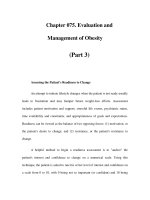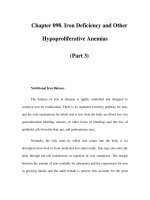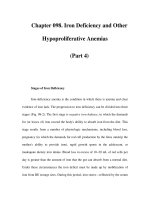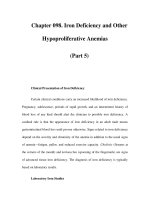Chapter 103. Polycythemia Vera and Other Myeloproliferative Diseases (Part 3) pptx
Bạn đang xem bản rút gọn của tài liệu. Xem và tải ngay bản đầy đủ của tài liệu tại đây (50.72 KB, 5 trang )
Chapter 103. Polycythemia Vera and Other
Myeloproliferative Diseases
(Part 3)
Diagnosis
When PV presents with erythrocytosis in combination with leukocytosis,
thrombocytosis, or both, the diagnosis is apparent. However, when patients present
with an elevated hemoglobin or hematocrit alone, or with thrombocytosis alone,
the diagnostic evaluation is more complex because of the many diagnostic
possibilities (Table 103-2). Furthermore, unless the hemoglobin level is ≥20 gm%
(hematocrit ≥60%), it is not possible to distinguish PV from disorders causing
plasma volume contraction. Uniquely in PV, an expanded plasma volume can
mask an elevated red cell mass; thus, red cell mass and plasma volume
determinations are mandatory to establish the presence of an absolute
erythrocytosis and to distinguish this from relative erythrocytosis due to a
reduction in plasma volume alone (also known as stress or spurious erythrocytosis
or Gaisböck's syndrome). This is true even in with the discovery of the JAK2
V617F mutation, because not very patient with PV expresses this mutation, while
patients without PV do. Figure 58-18 illustrates a diagnostic algorithm for the
evaluation of suspected erythrocytosis.
Table 103-2 Causes of Erythrocytosis
Relative erythrocytosis: Hemoconcentration secondary to dehydration,
androgens, or tobacco abuse
Absolute erythrocytosis
Hypoxia
Carbon monoxide intoxication
High affinity hemoglobin
High altitude
Pulmonary disease
Right-to-left shunts
Sleep-apnea syndrome
Neurologic disease
Renal disease
Renal artery stenosis
Focal sclerosing or membranous glomerulonephritis
Renal transplantation
Tumors
Hypernephroma
Hepatoma
Cerebellar hemangioblastoma
Uterine fibromyoma
Adrenal tumors
Meningioma
Pheochromocytoma
Drugs
Androgens
Recombinant erythropoietin
Familial
(with normal hemoglobin function, Chuvash, erythropoietin
receptor mutations)
Polycythemia vera
Once absolute erythrocytosis has been established, its cause must be
determined. An elevated plasma erythropoietin level suggests either a hypoxic
cause for erythrocytosis or autonomous erythropoietin production, in which case
assessment of pulmonary function and an abdominal CT scan to evaluate renal and
hepatic anatomy are appropriate. A normal erythropoietin level does not exclude a
hypoxic cause for erythrocytosis. In PV, in contrast to hypoxic erythrocytosis, the
arterial oxygen saturation is normal. However, a normal oxygen saturation does
not exclude a high-affinity hemoglobin as a cause for erythrocytosis;
documentation of previous hemoglobin levels and a family study are important.
Other laboratory studies that may aid in diagnosis include the red cell
count, mean corpuscular volume, and red cell distribution width (RDW). Only
three situations cause microcytic erythrocytosis: β-thalassemia trait, hypoxic
erythrocytosis, and PV. With β-thalassemia trait the RDW is normal, whereas with
hypoxic erythrocytosis and PV, the RDW is usually elevated due to iron
deficiency. In many patients, the LAP level is also increased, as is the uric acid
level. Elevated serum vitamin B
12
or B
12
-binding capacity may be present. In
patients with associated acid-peptic disease, occult gastrointestinal bleeding may
lead to presentation with hypochromic, microcytic anemia.
A bone marrow aspirate and biopsy provide no specific diagnostic
information since these may be normal or indistinguishable from ET or IMF, and
unless there is a need to establish the presence of myelofibrosis or exclude some
other disorder, these procedures need not be done. Although the presence of a
cytogenetic abnormality such as trisomy 8 or 9 or 20q– in the setting of an
expanded red cell mass supports a clonal etiology, no specific cytogenetic
abnormality is associated with PV, and the absence of a cytogenetic marker does
not exclude the diagnosis.









